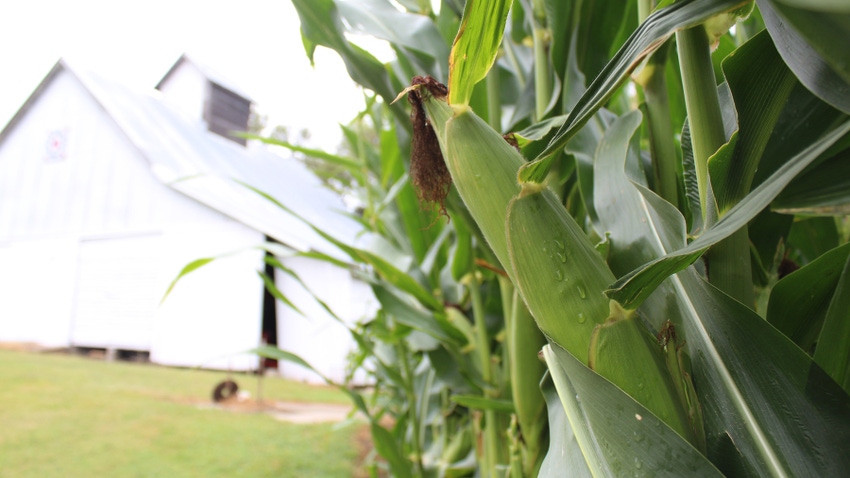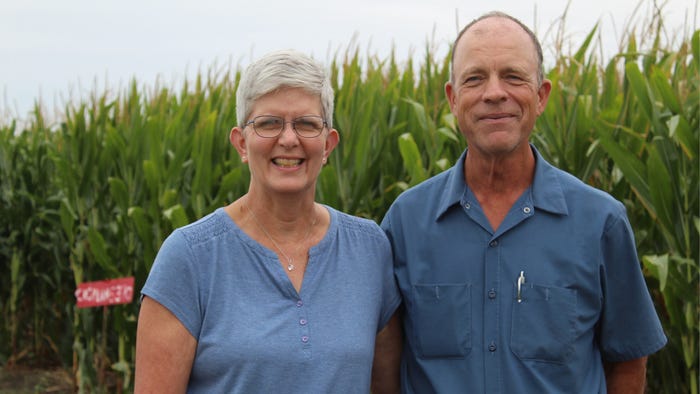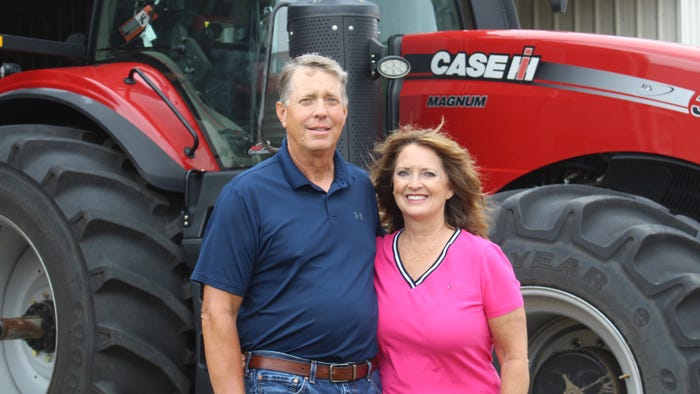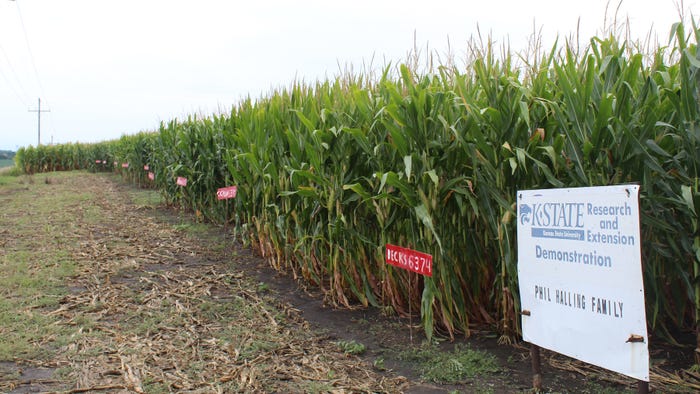
Editor’s note: This is the last in a three-part series featuring the Class of 2022 Kansas Master Farmers and Master Farm Homemakers. Read Part 1 at https://bit.ly/KMFpart1. And read Part 2 at bit.ly/KMFpart2.
If you take care of the land and the livestock, they’ll take care of you and yours.
For all six families of the class of 2022 Kansas Master Farmers and Master Farm Homemakers, if there is one common thread that ties them together, it could be a strong commitment to the land and their livestock.
And that is certainly the case for these Kansas Master Farmers and Master Farm Homemakers.
The Hallings
Phil and Jane Halling farm near Lancaster, Kan., in Atchison County. In 1978, at the age of 17, Phil purchased his first 100 tillable acres near Lancaster with his brother Tom.

HALLINGS: Phil and Jane Halling farm near Lancaster, Kan., in Atchison County, and are members of the Class of 2022 Kansas Master Farmers and Master Farm Homemakers.
Phil and Jane were married in 1981, and together they built their farm, while working and volunteering in the community. Phil has worked off the farm for more than 30 years, 22 of which was at the Rail Car Division of Rockwell in Atchison. Jane worked at the Exchange Bank in Atchison until their first child was born in 1985, and she stayed home to raise Allen and then their son Todd. While the boys were in school, she volunteered with Lancaster Elementary School, and eventually began working as a secretary for Unified School District 377 once the children were in middle school.
The Halling brothers eventually divided their farm assets and now farm separately, but they help each other when they can. Phil and Jane raise corn and soybeans and background some cattle. They both have been active leaders in the Atchison County Farm Bureau, with Phil serving four years as president and Jane serving more than a decade as secretary. Phil also has cooperated with K-State Research and Extension to host a corn field trial on his land for more than 20 years.
The Knudsons
Nearby, in Brown County, Mark and Marcia Knudson farm near Hiawatha, Kan. Mark and Marcia grew up in the same community, attended the same church, were both 4-H members and were both the fourth generation of their families to farm in the county. They married in 1989, and started raising their four children: Tricia, twins Matthew and Michael, and Meredith.

KNUDSONS: Mark and Marcia Knudson farm near Hiawatha, Kan., in Brown County. They’re members of the Class of 2022 Kansas Master Farmers and Master Farm Homemakers.
Marcia worked in banking and insurance until the twins were born in 1991. She started hauling grain for the farm, and today, fall harvest is her favorite part of the year.
Both of their families can trace their roots back to great-grandparents who immigrated from Norway in the late 1800s, and taking care of the land that’s been in the family for more than a century is important to them. When Mark started farming with his family in 1980, after he graduated from high school, he made it a point to use the tools and research available to improve the land and the business. For example, they formed a family corporation in 1981. They started experimenting with no-till in 1988 in response to a drought. And when a tornado in 1995 took much of their hog barns, they chose to disperse the hogs and focus more on their cow-calf herd. Today Mark and Marcia grow corn, soybeans, and hay in a no-till system, and their sons Matthew and Michael are joining the family farm.
Kansas Farmer. Farming has its highs and its lows. How did you overcome adversity?
Hallings. “Aug. 4, 1978, I was working third shift in town and (my brother) was working second shift, and we were told, ‘No way you’ll ever get that place to pay. You’d better keep your jobs in town,’” Phil said of that first farm purchase. “And we did for quite a while. Because interest rates were 9.5% — and the next time it renewed, it was 13.5%.” That job at the steel foundry in town, he added, was what it took. Jane added that they had a lot of support from family and neighbors when the boys were young to manage their growing family and the farm.

FARM PLOTS: The Hallings are cooperators with the Kansas State University Research and Extension Service and host demonstration plots on their farm each year to showcase corn varieties in the area. This has helped them make key decisions on implementing different technologies or choosing varieties for their farm.
Knudsons. “My dad was talking to a farmer-banker in 1981, and he said it might be a good idea to incorporate the farm since I was coming on,” Mark said. “Lot of credit goes to the second and third generation to get us where we were at, because the interest rates were crazy. Our twin boys are the fifth generation and are farming with us.” He said learning from the previous generations how to weather tough times to get to the better times was key. Marcia added that volunteering with community and church activities helps ground them, and reminds them that there is a community surrounding them with support.
What conservation tools or tactics are you most proud of implementing on your farm?
Hallings. “We weren’t the first to instigate no-till,” Phil said. “It was a few years before we got into it.” The selling point was that no-till made it possible for Phil to farm ground by himself, rather than trading off tilling the soil and planting with his brother. That matched his work schedule in town. Phil also used his own equipment to put in tile lines in fields, which helped him not only control soil and water runoff but help speed up his farming as well.
Knudsons. “We’ve started experimenting with cover crops now,” Mark said. “We’ve flown on some with an airplane: turnips, radishes and rye. But the last two years, we’ve been drilling rye, and that seems to make a nice seedbed to go into the next year. We will graze some of that rye. It is a great food source.”
Using no-till really changed the game for the Knudsons. “Back in the day we used to field-cultivate over and over again,” Mark said. “We have more time now with the spraying and can get in and plant. The benefits of it is, the soil texture really builds and you have more worms that are doing the work for you. Soil conservation is our key thing here.” Mark’s conservation efforts have recently extended into a whole new realm — pheasants. The area has experienced a severe decline of game birds, and Mark has started a project raising and releasing pheasants in the area to build numbers back.

NEXT GENERATION: Mark Knudson and his twin sons, Matthew and Michael, look over a corn plot near the family farmstead outside of Hiawatha. Mark and his wife, Marcia, are proud that their sons will be the fifth generation to farm the same ground that was settled by their Norwegian ancestors. That duty to the legacy drives them to implement conservation tools for their land and their water resources.
How do cattle work in your diversified farm plan?
Knudsons. In 1995 low markets and a tornado drove them to liquidate their hog herd. With practicality they chose to expand their cow-calf herd instead. “When I started, we had polled Hereford. Then black Angus got popular, so we slowly used an Angus bull on our Herefords and switched into an Angus herd,” Mark said. The commercial herd is divided between spring- and fall-calving, with cows calving out on cornstalks. “We have quite a bit of hay from waterways and other places, so the cattle are a way to use that hay,” Mark added. “I like fall grazing, and feed hay out there in those fields to help the soils a little more. I prefer the animals to do the work, but it takes a lot of time stringing hot wire. We do chop some silage, too.”
Hallings. “I’ve got pasture I can’t farm, and a little bit of hay in the wintertime, and so that goes through our background calves. We go out and buy them from the sale barn,” Phil said. It’s something to do in the winter, he said with a smile.
You’ve each approached building your farms and your families using K-State Research and Extension expertise in some form. How important was that learning partnership to you?
Knudsons. “My grandma actually helped start the local club I was in and our kids were in, but 4-H and Extension really helped our kids build self-confidence, responsibility and working together helping others,” Marcia said. For Mark, Extension helped him switch gears from going to college to be a dentist, to coming home to farm with his father after a tragic accident changed the family. “It was an outreach from the university to give me the latest information — what we needed to improve on my dad’s experience,” Mark said “I went to every meeting; it helped me a lot. We used their test plot information to improve our hybrids.” Getting involved with Extension programming helped him hit the ground running and grow his practical farm skills.
Hallings. “Having a test plot on my farm, I can see how different varieties do on my ground,” Phil said. “It’s helped me; it’s changed me some, too.” Whether it was Extension providing an answer to an agronomy question from Phil or helping Jane with a question in the kitchen, the Hallings say Extension had a key role in their family’s success.
About the Author(s)
You May Also Like






